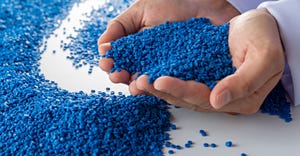The answer to sustainability isn’t blowing in the wind
May 16, 2016

Image courtesy xedos4/freedigitalphotos.net. |
There’s a lot of hype being dished out by large corporations about the “carbon neutral” status of their manufacturing operations by using wind and solar to produce energy. If you just read the headlines and maybe a few lines of the first paragraph, it almost sounds like these companies have gone off the grid. However, a careful reading of their reports and press releases is warranted to understand what they really mean.
Recently, PlasticsToday reported about Mars moving to “green” bioplastic packaging for its candy bars. The company is also moving forward on some other so-called “eco-friendly” initiatives. For example, here’s a headline from Mars Inc.: "Mars Moves Towards Carbon Neutral Operations with Massive Wind Farm that Will Provide Electricity from Renewable Sources Equal to its Entire U.S Operations." Pretty impressive . . . at first glance. The announcement, made in April 2014, explained that Mars, in partnership with Sumitomo Corp. of Americas, would build a new 200-megawatt wind farm that will generate 100% of the electricity needs of Mars’ U.S. operations, which includes 37 factories and 25,000 associates.
My first thought upon reading the headline was, Wow! The company is putting in wind farms to run its operations! But upon further reading the release, here’s what I found: The Mesquite Creek Wind farm, a 118-turbine wind farm on 25,000 acres near Lamesa, TX, will have an annual output of over 800,000 megawatt-hours, representing 24% of Mars’ total global factory and office carbon footprint, as part of its Sustainable in a Generation initiative. The energy from the wind farm is equivalent to the electricity required to power 61,000 U.S. households.
So, Mars isn’t actually going to use wind-power generators at its factories. It’s going to be a trade-off in that 61,000 households near the Lamesa wind farm will be able to choose renewable energy from the wild West Texas winds to power their homes. Mars, on the other hand, will keep on using strong, reliable electricity from traditional sources to run its plants. Ultimately, the power companies remain in charge of how much electricity is being produced by small businesses.
A recent editorial in the Wall Street Journal notes that more and more utility companies across the United States are investing in wind and solar, not because they are feeling altruistic or particularly green (in the ecological sense), but because there are a lot of greenbacks to be had in the form of subsidies that the government hands out (from our tax dollars) to promote green energy. This gives the mainstream utility companies control over the energy that is produced from renewable sources like the sun and wind while allowing them to continue to produce energy from traditional sources, and, of course, raking in additional revenue from government subsidies.
It’s obvious that solar and wind do not produce steady, reliable energy—the kind that it would take to run large manufacturing facilities—or Mars would be erecting its own solar and wind farms. A private wind farm near a Mars plant would require many thousands of acres, and land is still pretty expensive, even in rural areas. Manufacturing plants require the dependability of coal and natural gas to maintain operations on the scale of a company the size of Mars.
The Mesquite Creek Wind Farm will also be able to operate without the worry of being fined by the EPA for killing endangered species of birds. An editorial in the May 16 issue of the Wall Street Journal by Robert Bryce (“An Ill Wind: Open Season on Bald Eagles”) notes that the “U.S. Fish and Wildlife Service, the agency charged with protecting bald and golden eagles, is once again trying to make it easier for the wind industry to kill those birds.”
Bryce reviewed the new steps taken by that agency to “extend the length of permits for accidental eagle kills from the current five years to 30 years. The changes would allow wind-energy producers to kill or injure as many as 4,200 bald eagles every year.” He also noted that a 2013 study in the Wildlife Society Bulletin, “estimated that wind turbines killed about 888,000 bats and 573,000 birds (including 83,000 raptors) in 2012 alone.” Who knows how many birds and raptors have been killed since that year because, as Bryce pointed out, the wind industry doesn’t have to report bird kills.
While the wind industry may see bird and raptor kills as just collateral damage in the effort to save the planet from the evils of fossil fuels, the American Bird Conversancy is fighting these attempts to exempt the industry from any penalties for these illegal kills. Perhaps this will also be the start of a new not-for-profit organization that Mars and other large manufacturers engaging in these trade-offs, can fund: Raptor rehabilitation centers, where the birds that are only badly injured can be rehabilitated.
This is just another example of the law of unintended consequences at work. I think I’ll remember that the next time I’m tempted to buy a Mars candy bar.
About the Author(s)
You May Also Like




